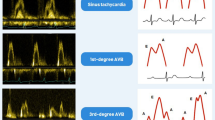Abstract
Background: Telemetric surveillance systems are part of a well-accepted and evolving field in the care of cardiac patients. Especially in patients with implanted cardioverter-defibrillators (ICD), they are well established and their usefulness and reliability have been shown in several clinical trials. Currently, three generations of Home Monitoring™ (HM, Biotronik GmbH & Co. KG, Berlin, Germany) are commercially available. Methods: This paper presents three cases demonstrating the various limitations of the first and second generations of HM and the way they can be overcome by the third generation. Results: In the first case, atrial flutter was misinterpreted by the device and classified as ventricular tachycardia (VT). Thus, in the online IEGM, supraventricular tachycardia was identified, and the short IEGM strip and lack of transmitted atrial signals of the dual-chamber device necessitated an appointment for ICD interrogation, to clarify the diagnosis and propose further treatment. The second case is that of a patient in whom a VT was ineffectively treated by anti-tachycardia pacing (ATP) and continued with longer cycle length, leading to syncope. A second-generation HM device with online- IEGM misleadingly appears to indicate successful treatment. The third case demonstrates correct detection and therapy of a fast VT by an ICD of third-generation HM type. The online IEGM now gives all information needed for complete telemetric assessment. Conclusions: Home Monitoring (HM) is a helpful remote surveillance tool for the early detection of both arrhythmias and technical problems. As shown, the first two generations had limitations which the patient must take into account when using the system. These limitations have been overcome in the third generation, making Home Monitoring more self-sufficient and reliable.
Similar content being viewed by others
References
Stellbrink C, Hartmann A, Igidbashian D et al. Home monitoring for pacemaker therapy: intermediate results of the first European Multicenter study (Abstract). Pacing Clin Electrophysiol 2002; 25: 686.
Varma N, Stambler B, Chun S et al. Detection of atrial fibrillation by implanted devices with wireless data transmission capability. Pacing Clin Electrophysiol 2005; 28: S133–6.
Lazarus A. Remote, wireless, ambulatory monitoring of implantable pacemakers, cardioverter defibrillators, and cardiac resynchronization therapy systems: analysis of a worldwide database. Pacing Clin Electrophysiol 2007 (Suppl 1): S2–12.
Ricci RP, Morichelli L, Santini M. Home monitoring remote control of pacemaker and implantable cardioverter defibrillator patients in clinical practice: impact on medical management and health-care resource utilization. Europace doi:10.1093/eum289 epub Jan 16, 2008.
Brugada P. What evidence do we have to replace in-hospital implantable cardioverter defibrillator follow-up? Clin Res Cardiol 2006; 95: iii3–9.
Ritter O, Bauer WR. Use of “IEGM Online” in ICD patients — early detection of inappropriate classified ventricular tachycardia via Home Monitoring. Clin Res Cardiol 2006, 95: 368–72.
Varma N et al. Lumax-T/Lumos-T safely reduces routine office device follow-up. American Heart Association 2008, Presentation No. 4078, Abstract No. 22578.
Author information
Authors and Affiliations
Corresponding author
Rights and permissions
About this article
Cite this article
Spencker, S., Coban, N., Koch, L. et al. Limitations of the past and latest evolutions of home monitoring: arrhythmia electrograms transmitted automatically improve the efficacy of remote monitoring. Aging Clin Exp Res 22, 459–465 (2010). https://doi.org/10.1007/BF03337741
Received:
Accepted:
Published:
Issue Date:
DOI: https://doi.org/10.1007/BF03337741




